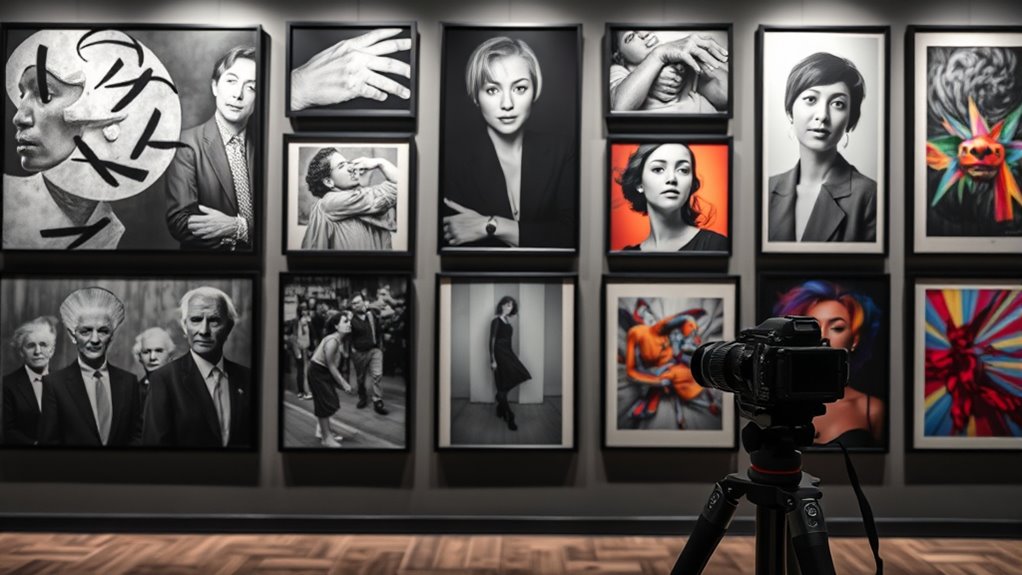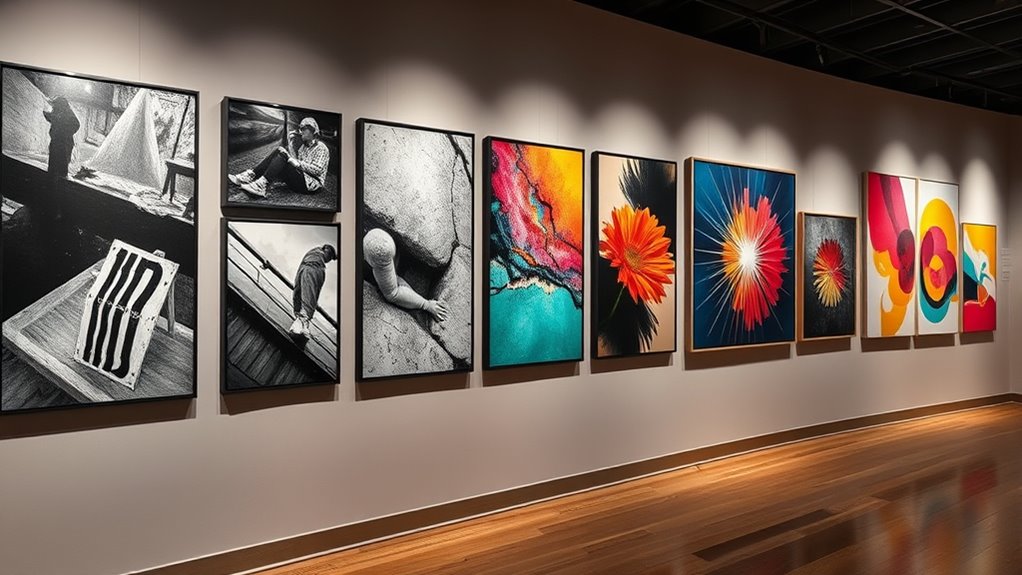You can see how photography evolved from ancient studies of light to a major art form by exploring its technological breakthroughs and artistic movements. From early experiments like Niépce’s first photos to modern digital innovations, photography now challenges perceptions and explores identity through diverse styles and techniques. Influential artists and new technologies like AI and drones continue to push boundaries. To discover how these developments shape today’s creative landscape, keep exploring further.
Key Takeaways
- Digital technology and social media have democratized photography, enabling instant sharing, experimentation, and expanding its role as a contemporary art form.
- Conceptual artists challenge traditional aesthetics, using photography for cultural commentary, identity exploration, and interdisciplinary practices.
- Innovative tools like AI, VR, and drones create new perspectives, pushing boundaries of visual storytelling and artistic experimentation.
- Major galleries, exhibitions, and institutions now recognize photography as a vital, evolving component of contemporary art.
- The fusion of photography with other media and digital techniques has transformed it into a versatile, expressive tool in contemporary artistic practices.
Foundations of Photography: From Invention to Artistic Movements

The foundations of photography trace back to ancient civilizations that explored optics and light projection, laying the groundwork for capturing images. You learn that Chinese and Greek philosophers studied light and vision, influencing early device development. Johann Heinrich Schulze’s discovery that silver nitrate darkens in light becomes a crucial step toward permanence in photography. The camera obscura, used for centuries, projected images and inspired future camera designs. In 1826, Nicéphore Niépce took the first permanent photograph after an eight-hour exposure, marking a milestone. Around 1839, Louis Daguerre and William Henry Fox Talbot introduced processes—the daguerreotype and calotype—that produced images on metal and paper. These innovations set the stage for photography’s artistic and technical evolution, shaping its role as a medium for art and documentation. Additionally, technological advances such as the development of film and digital sensors have further transformed photography into a versatile artistic medium.
The Rise of Modern Photography and Its Artistic Expansion

Building on the technical innovations and artistic shifts that shaped early photography, the modern era saw the medium evolve into a powerful tool for artistic expression. You witness key figures like Alfred Stieglitz and Edward Steichen elevating photography to fine art, while pioneers like Bernd and Hilla Becher use conceptual approaches. Movements like Dadaism, Surrealism, and Pop Art challenged conventions, inspiring experimentation and new perspectives. Technological advances, such as portable cameras and improved film, expanded creative possibilities. Photographers began capturing industrial landscapes, urban life, and social issues, reflecting societal change. The rise of galleries and exhibitions, like Stieglitz’s 291 Gallery, helped establish photography’s artistic legitimacy. Additionally, the adoption of organic farming techniques in some circles has influenced how artists approach the environmental themes in their work, emphasizing sustainability and ecological awareness. Here’s a quick look at influential figures, movements, and innovations:
| Figures | Movements |
|---|---|
| Alfred Stieglitz | Dadaism |
| Bernd & Hilla Becher | Surrealism |
| Thomas Ruff & Gursky | Pop Art |
Recognizing Photography as an Art Form in the Late 20th Century

By the late 20th century, the art world fully embraced photography as a legitimate art form, thanks to groundbreaking exhibitions and recognition from major institutions. The digital revolution transformed how artists create and share work, pushing boundaries and expanding artistic possibilities. Pioneering contemporary photographers challenge conventions, shaping the medium’s evolving role in the broader art landscape. The emergence of digital tools and techniques further solidified photography’s status within contemporary art practices, enabling new forms of expression and experimentation. Additionally, an increased emphasis on Self-Understanding within the artistic community has encouraged more authentic and innovative photographic works, supported by a growing appreciation for visual storytelling as a means of conveying complex narratives and emotions. Furthermore, the integration of cryptocurrency and digital platforms has opened new avenues for artists to monetize and distribute their work globally, reflecting the increasing influence of resources and tools in contemporary art creation.
Art World Acceptance
As the 20th century progressed, photography’s status as a legitimate art form gained widespread recognition among critics, institutions, and the public. Major museums began collecting and exhibiting photographs, establishing its artistic validity. Photography departments appeared in art schools, and the medium became a subject of academic study and critique. Art movements like Conceptual and Pop Art integrated photography as a core element. You’ll notice that:
- Photographic works featured prominently at biennials and art fairs
- Auctions saw photographic prints fetch prices rivaling traditional artworks
- Artists combined photography with other media, blurring genre lines
- Photography became a tool for social commentary, activism, and conceptual exploration
- Hydrocolloid technology further expanded the possibilities and acceptance of photographic art in contemporary galleries and collections
- The development of digital imaging techniques significantly enhanced the creative and production capabilities of photographers, further solidifying their role as contemporary artists
This shift cemented photography’s place in the contemporary art world, reflecting its evolving cultural significance.
Digital Revolution Impact
The advent of digital technology in the late 20th century revolutionized photography, transforming it from a primarily analog craft into a dynamic and versatile art form. You now have instant image preview and feedback, which changes your creative process. Digital cameras replaced film, with memory cards storing thousands of images, making experimentation easier and less costly. The rise of software like Adobe Lightroom allows precise editing, fostering new artistic styles. Mirrorless cameras offer high quality in compact designs, broadening artistic possibilities. Societal impacts include affordable, user-friendly devices and social media platforms enabling instant sharing. This revolution democratized photography, making it accessible and participatory. Additionally, the integration of natural lighting techniques into digital workflows has further expanded creative horizons for photographers, emphasizing the importance of lighting control in achieving desired artistic effects.
Pioneering Contemporary Artists
Have you ever wondered how contemporary artists have pushed photography beyond traditional boundaries? They’ve redefined the medium with innovative techniques and bold visions. Wolfgang Tillmans experiments with conceptual and abstract forms, challenging perceptions of reality. Rineke Dijkstra revisits classical portraiture through large-scale, modern lenses. Richard Avedon creates striking, iconic portraits that capture raw emotion, while Eve Arnold documents intimate moments, elevating storytelling. Manuel Alvarez Bravo brings Latin American narratives into the spotlight with his distinctive style. These pioneers have expanded photography’s artistic scope, influencing modern practices and perceptions. Their work, exhibited in top galleries and collections, shows how photography has become a respected art form. Recognizing photography as a formal art has been crucial in establishing its credibility in the art world. Additionally, the stylistic diversity within contemporary photography demonstrates its versatility as an art form. Recognizing photography as a formal art has been crucial in establishing its credibility in the art world.
Pioneering Techniques and Styles in Contemporary Photography

Ever wonder how contemporary photographers push creative boundaries? They do it through innovative techniques and evolving styles. High-contrast imagery emphasizes dramatic light and shadow, telling powerful stories visually. Retro effects like grainy textures and black-and-white filters evoke nostalgia and vintage charm. Minimalist compositions strip images down to simple, elegant forms, creating timeless appeal. Cinematic storytelling captures movement and emotion, giving photos a movie-like quality. Drone photography offers aerial perspectives that redefine landscapes and architecture. Emerging styles like moody tones deepen emotional impact, while bold colors energize visual narratives. Fish-eye lenses add playful distortion, and panoramic shots embrace social media trends. These pioneering approaches challenge traditional boundaries, making photography not just a craft, but a dynamic form of Cultural and Historical Symbols. Incorporating techniques from other art forms continues to inspire experimentation and innovation within contemporary photography. Additionally, embracing digital manipulation allows artists to explore new realms of creativity beyond traditional methods. Moreover, interactive media techniques foster greater audience engagement and storytelling possibilities.
Influential Artists Shaping Today’s Visual Culture

You see how today’s visual culture is shaped by influential artists pushing boundaries and exploring new ideas. Pioneers of conceptual art challenge your perceptions, while digital innovators transform how photography is created and experienced. Their work continues to redefine the role of photography in art and society, with visual storytelling playing an increasingly vital role in engaging audiences worldwide. Additionally, the integration of predictive modeling and AI-driven tools in artistic processes allows for new forms of creative expression and audience interaction.
Pioneers of Conceptual Art
Pioneers of conceptual art have profoundly shaped today’s visual culture by challenging traditional notions of photography and emphasizing ideas over aesthetics. They push boundaries by blending media, questioning authorship, and exploring identity. You can see their impact through influential artists like:
- John Baldessari, who combines text and images to explore language and visuals
- Cindy Sherman, whose self-portraits probe identity and representation
- Sherrie Levine, critiquing originality through appropriation
- Richard Prince, challenging notions of authorship and copyright
These artists use their work as a form of cultural commentary, often working within institutional spaces like museums and galleries. Their approach invites you to rethink what photography can be, emphasizing concepts and ideas over traditional beauty or technical perfection.
Digital Innovators Transforming Photography
How have digital innovations reshaped photography and influenced today’s visual culture? You now have access to advanced tools that allow for incredible manipulation and editing, expanding creative possibilities. Social media platforms like Instagram and TikTok let you showcase work globally, connect instantly, and build communities. Improvements in camera tech, such as mirrorless and smartphone cameras, make high-quality photography accessible to everyone. Digital techniques enable experimentation with collages, mixed media, and immersive experiences, pushing artistic boundaries. Influential artists like Annie Leibovitz, Steve McCurry, and Jordi Koalitic inspire new visual narratives through innovative styles and collaborations. Technologies like drones, AI editing, and VR open fresh perspectives, transforming how you capture, share, and experience images, shaping the dynamic landscape of contemporary photography.
The Impact of Technology and Digital Media on Artistic Photography

The rise of digital media has profoundly transformed artistic photography, breaking down traditional boundaries and expanding creative possibilities. You now have access to tools that enable limitless experimentation and innovation. Digital platforms and social media have revolutionized how you share and showcase your work, reaching global audiences instantly. The integration of AI and AR technologies is redefining image capturing and interaction, creating immersive experiences. You can easily manipulate images with sophisticated editing software, pushing artistic expression beyond previous limits.
- Use smartphones to capture most photos, making photography accessible.
- Experiment with digital cameras, reducing costs and barriers.
- Explore new creative avenues with digital editing tools.
- Blur the lines between reality and digital art with innovative tech.
Frequently Asked Questions
How Did Early Photographic Techniques Influence Contemporary Digital Art?
You see that early photographic techniques laid the foundation for digital art today. Techniques like manipulation in the darkroom and collage inspired digital editing tools, allowing you to blend, layer, and distort images creatively. These methods encouraged experimentation and challenged notions of truth, which you now explore with digital software like Photoshop. The core principles of composition, lighting, and exposure remain central, but now you have virtually unlimited tools for artistic expression.
What Role Do Social Media Platforms Play in Modern Photographic Art Dissemination?
Social media platforms play a crucial role in modern photographic art dissemination by giving you a vast global audience. You can easily share your work, connect with others, and participate in trends. These platforms make photography more accessible and interactive, allowing your images to reach millions instantly. Despite challenges, social media democratizes art, enabling you to showcase your creativity, gain recognition, and influence online culture through visual storytelling.
How Do Cultural Differences Shape Contemporary Photographic Styles Globally?
You might wonder how cultural differences shape modern photography worldwide. Well, these influences run deep—colors, symbols, and storytelling reflect local traditions and attitudes. In some regions, street photography thrives, capturing daily life authentically, while others impose restrictions. Your perspective shifts when you realize that each photograph carries a cultural story, revealing unique worlds through your lens. Embrace these diverse styles, and you’ll see how culture profoundly molds contemporary photography.
What Ethical Considerations Are Prominent in Contemporary Photographic Practices?
In contemporary photography, you must prioritize ethics by obtaining clear consent before photographing individuals, especially in private or sensitive settings. Be honest about any digital manipulations, avoiding misleading edits. Respect your subjects’ agency and cultural sensitivities, and consider the environmental and community impacts of your work. By practicing transparency, respecting privacy, and minimizing harm, you help uphold integrity and trust in your photography.
How Is Artificial Intelligence Transforming Creative Possibilities in Photography?
Think of AI as a paintbrush that unlocks new worlds in your photography. It transforms your creative possibilities by automating tedious tasks, enhancing image quality, and helping you craft surreal or abstract visuals impossible to achieve manually. With AI, you can explore innovative ideas, experiment with different styles, and push artistic boundaries, making your photography a vibrant canvas where imagination and technology merge seamlessly.
Conclusion
As you explore contemporary photography, remember it’s like a river constantly flowing and reshaping itself. Just as a photographer captures fleeting moments to create lasting art, technology continually transforms the medium, pushing boundaries and expanding possibilities. Today’s artists navigate this dynamic current, blending tradition with innovation. Embrace this evolution, knowing that each click of the shutter adds a new ripple—forever shaping the ever-changing landscape of visual culture.










